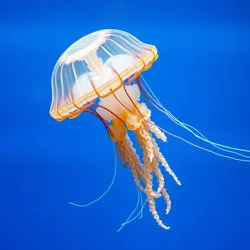Cnidarians

Cnidarians are a diverse group of aquatic animals known for their distinctive stinging cells, called cnidocytes, which they use for capturing prey and defense. This phylum includes well-known marine species such as jellyfish, sea anemones, and corals. Cnidarians are primarily marine organisms, though some species inhabit freshwater environments.
Characteristics
Cnidarians possess a simple body structure that is typically radially symmetrical. They have two main body forms: the sessile polyp and the free-floating medusa. The polyp form is typically tubular and attached to a substrate, while the medusa form is umbrella-shaped and mobile.
Body Structure
- Tissue Organization: Cnidarians are diploblastic, meaning they have two primary tissue layers: the epidermis and the gastrodermis, separated by a gelatinous substance called mesoglea.
- Nervous System: They possess a simple nerve net instead of a centralized nervous system, allowing them to respond to environmental stimuli.
- Digestive System: Cnidarians have a single opening that serves as both mouth and anus, leading to a central gastrovascular cavity where digestion takes place.
Cnidocytes
The defining feature of cnidarians is their cnidocytes, specialized cells that contain organelles called nematocysts. These structures deliver toxins to prey or predators, aiding in both capture and defense.
Reproduction
Cnidarians can reproduce both sexually and asexually. Sexual reproduction typically involves the release of gametes into the water, leading to external fertilization. Asexual reproduction often occurs through budding, where new individuals form from the body of a parent organism.
Ecological Role
Cnidarians play a critical role in marine ecosystems. Corals, for example, form coral reefs, which are among the most biodiverse habitats on the planet. These reefs provide shelter and resources for numerous marine species.
- Predators and Prey: Cnidarians are both predators and prey within their ecosystems. Their stinging cells make them effective predators of small fish and plankton.
- Symbiotic Relationships: Many cnidarians, such as corals, engage in symbiotic relationships with algae, which provide them with nutrients through photosynthesis.
Evolutionary Significance
Cnidarians are one of the earliest diverging animal lineages, providing insight into the evolution of complex life forms. Their simple body plan and unique features make them a subject of interest in evolutionary biology.
Research and Applications
Recent studies have focused on the potential applications of cnidarian bioactive compounds in medicine, particularly their toxins, which have shown promise in developing new pharmaceuticals. Additionally, cnidarians are model organisms in the field of developmental biology due to their simple body plan.
See Also
- Robo-Nautilus
- Aqua Squid
- Bioluminescent Ecosystems
- Aquatech Innovations
Cnidarians continue to captivate scientists and marine enthusiasts alike, not only for their ecological significance but also for their intriguing biological properties and evolutionary history. As research progresses, these fascinating creatures may offer further insights into both the natural world and potential technological applications.